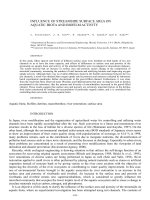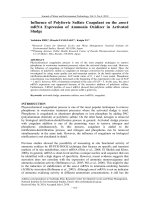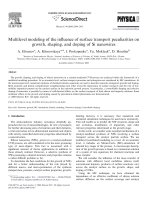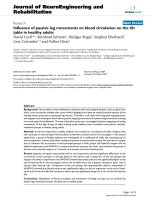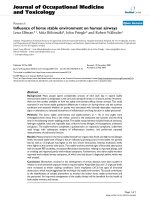The influence of the design parameters on the profile sliding in an internal hypocycloid gear pair
Bạn đang xem bản rút gọn của tài liệu. Xem và tải ngay bản đầy đủ của tài liệu tại đây (598.51 KB, 10 trang )
Vietnam Journal of Science and Technology 56 (4) (2018) 482-491
DOI: 10.15625/2525-2518/56/4/9625
THE INFLUENCE OF THE DESIGN PARAMETERS ON THE
PROFILE SLIDING IN AN INTERNAL HYPOCYCLOID GEAR
PAIR
Nguyen Hong Thai1, *, Truong Cong Giang1, 2
1
2
School of Mechanical Engineering, Hanoi University of Science and Technology,
No 1 Dai Co Viet, Ha Noi
Vinh Phuc Technical and Economic College, No 2 Dong Tam, Vinh Yen, Vinh Phuc
*
Email:
Received: 11 April 2017; Accepted for publication: 16 July 2018
Abstract. While hypogerotor pump working, the profiles of the inner and outer rotors match
together following gearing rule of the hypocycloidal gear-set. Therefore, those two opposite
profiles matching each other like in generation process, and during action, one will roll and slip
in relation with the other. Relative sliding between two profiles in the contact point causes
wearing out of the tooth profile. Aiming to evaluate influence of the geometrical dimension
parameters of the pump rotor profile on the wear, in this paper, the authors established equation
for determining slip coefficient from geometrical dimensions. Furthermore, the authors have
investigated and evaluated the phenomenon of the profile slipping to find out the geometrical
dimensional parameters for avoiding unequal wearing of the inner and outer rotors of the
hypogerotor pump.
Keywords: hypogerotor pump, profile slipping, hypocycloidal gear.
Classification numbers: 5.5.1, 5.6.1, 5.10.1.
1. INTRODUCTION
Hypogerotor pump is designed by internal
matching principle of the hypocycloidal gear-train.
In that pump, the tooth profile of outer gear is
hypocycloidal, and that of the matching inner gear
is circular. Also, the relation between the number
of teeth of the outer gear (z2) and inner gear (z1)
can be expressed as z2 = z1+1 [1]. On the other
hand, because of the matching characteristics of the
gear-train, the chambers in the pump are formed by
the profiles of the gears and the flange, as shown in
the Figure 1 [2, 3]. Also in this gear-train, the outer
gear participates in matching process with its whole
outer rotor
Inner rotor
Figure 1. Hypogerotor pump.
The influence of the design parameters on the profile sliding in an internal cycloid gear pair
hypocycloidal profile (from dedendum to addendum), meanwhile only the addendum part of the
circular-arc profile of the inner gear has involved into this process. Following page 60 [4], for
the cycloidal gear pair, the contact stress clearly will increase when two convex profiles are
matching each other. And logically, it leads to wear effect as in [5, 6], where the authors tried to
find the sliding velocity between the profiles of the epicycloidal gear pair. Therefore, it is
necessary to select an appropriate set of parameters when designing gear profiles (R1, rcl), to
ensure that both matching profiles will be worn equally and simultaneously. This is the main
goal of this research.
2. KINEMATIC ANALYSIS OF HYPOGEROTOR PUMP
In [8], the hypogerotor pump consists of the pair of internal matching hypocycloidal gears
with five parameters: E, R1, R, rcl, z1. Those parameters are shown in Figure 2.
t
v K 2 K1
’
vKt 1i
vKt 2i
β1i
R
v K 2 K1
vK1i
vK 2 i
β2i
t
vKt 1i
y2
y3
vKt 2i
y1
vK1i
β2i
vK2i
β1i
n′
Ki
β1i β2i
Bi
vKn1i ≡ vKn 2 i
v Kn1i ≡ v Kn 2 i
ω1
t
O1
O2
ω2
ϕ
E
γ
n′
Ki
n
r1
rcl
x3
P
Bi
x2
r2
β1i
x1
R1
r2
θ
a)
β2i
t
b)
rK 2i r
K1 i
Figure 2. Calculating scheme of sliding velocity at matching point K.
Where:
E:
eccentricity between two rotation centers of the inner and outer gears (center
distance),
R1: radius of the locus of the centers of the addendum circular arcs on the inner rotor,
R: radius of the dedendum arc of the inner rotor (mating with two consecutive addenda of
the inner rotor),
z1: number of teeth of the inner rotor,
rcl: radius of the addendum arc of the inner rotor.
483
αi
Nguyen Hong Thai, Truong Cong Giang
Following matching principle of the hypocycloidal gear-train, let P be the contact point
between circle of radius r1 Σ1(O1, r1) and circle of radius r2 Σ2(O2, r2). Then P will be the pitch
point (stationary in this case) and r1 = Ez1, r2 = Ez2.
Ki: are the contact point between the profiles of the outer and inner rotors, which K1i, K2i
belong to the inner and outer rotor, respectively.
Bi: are the center of the circular arc of the inner rotor adendum.
nn′, tt′: are the common normal and tangent at the arbitrary contact point Ki (matching
point), and nn′ always goes through P, Bi, Ki.
When the inner rotor is driven clockwise with the angular velocity ω1 around O1
(Figure 2), it also makes the outer rotor rotate around O2 with the angular velocity ω2 in the same
direction as ω1. The velocities of points Ki in the absolute motion can be written as:
v K1i (γ i ) = ω1 rK1i (γ i )
v K 2i (γ i ) = ω 2 rK 2 i (γ i )
(1)
where rK1i (γ i ) = O1K1i , rK 2i (γ i ) = O 2 K 2i
Projecting vK1i (γ i ) , vK 2 i (γ i ) onto tangent tt′ results in:
v Kt 1i (γ i ) = v K1i (γ i ) cos[β 1i (γ i )]
t
v K 2i (γ i ) = v K 2i (γ i ) cos[β 2i (γ i )]
(2)
in which β 1i (γ i ) , β 2i (γ i ) are the angles between vK1i (γ i ) , vK 2 i (γ i ) and tangent tt′ at Ki during
matching process. Subtituting (1) into (2) results in:
v Kt 1i (γ i ) = ω1 rK1i (γ i ) cos[β 1i (γ i )]
(3)
t
v K 2 i (γ i ) = ω 2 rK 2 i (γ i ) cos[β 2 i (γ i )]
where vKt 1i (γ i ) , vKt 2 i (γ i ) : are components of the sliding velocity at Ki, with K1i belongs to the
profile of the inner rotor, and K2i lies on the profile of the outer rotor. The parameters rK1i (γ i ) ,
rK 2i (γ i ) , β 1i (γ i ) , β 2i (γ i ) in equation (3) will be calculated in the sections 2.1, 2.2, 2.3.
2.1. Calculation of rK1i (γ i ) , rK 2i (γ i )
From equation (6) of [8], the coordinates of the point Ki in the fixed coordination system
ϑ3(o2y3x3) can be expressed as:
3 x K i (γ i ) = R1 cos γ i + rcl cos[α i (γ i ) + γ i ] + E
(4)
3
y K i (γ i ) = − R1 sin γ i − r cl sin[α i (γ i ) + γ i ]
Ez1 cos(γ i )
in which α i (γ i ) = tan −1
R1 − Ez1 sin(γ i )
From the equation (4), one can obtain:
(5)
rK 2 i (γ i ) = [ 3 x K i (γ i )] 2 +[ 3 y K i (γ i )] 2
484
The influence of the design parameters on the profile sliding in an internal cycloid gear pair
and
rK1i (γ i ) = [ 3 x K i (γ i ) − E ] 2 +[ 3 y K i (γ i )] 2
(6)
2.2. Calculation of cosβ1i(γi), cosβ2i(γi)
Applying the law of cosines to the triangle PO1Ki results in:
[rK (γ i )]2 + [ PK i (γ i )]2 − [ Ez1 ]2
cos β1i (γ i ) = 1i
2rK1i (γ i ) PK i (γ i )
(7)
and
[ rK 2i (γ i )]2 + [ PK i (γ i )]2 − [ E ( z1 + 1)]2
(8)
PK i (γ i ) = [3xK i (γ i ) − Ez2 ]2 +[3y K (γ i )]2
(9)
cos β 2i (γ i ) =
2rK 2i (γ i ) PK i (γ i )
where
i
2.3. Transmission ratio of the rotors
From equation (2) of [1], the gear ratio can be expressed as:
ω1 z1 + 1
i12 = ω = z
2
1
i = ω 2 = z1
21 ω1 z1 + 1
Case study
(10)
For the illustrative purpose, the parameters of the considered gearset are as follows: z1 = 5,
rcl = 7 mm, R1 = 26.25 mm, R = 30 mm, E = 3.5 mm.
v
Velocity (m/s)
velocity (m/s)
v
7
6.5
v2
2
1.5
6
1
5.5
v21
v1
0.5
5
4.5
0
50
100
150
200
250
300
350
Figure 3. Absolute velocities at K1i and K2i.
γ[o]
0
0
50
100
150
200
250
300
[o]
350 γ
Figure 4. Relative velocity V21 at Ki.
When the inner rotor is driven by ω1 = 157 (rad/s), the outer rotor is rotated with the same
direction ω2 = 130.8 (rad/s). In that case, velocities vK1i (γ i ) , vK 2 i (γ i ) at the contact points Ki are
shown in Figure 3. Figure 4 provides the graph of the relative sliding velocity vK 21 (γ i ) .
485
Nguyen Hong Thai, Truong Cong Giang
3. PROFILE SLIP COEFFICIENT
3.1. Equation for calculation of the profile slip coefficient
During matching process at Ki (contact point), one profile rolls and slides against the other.
The relative sliding velocity at the point Ki lies on the tangent tt′ and causes wear effect of the
profiles:
v tr12 i (γ i ) = v Kt 1i (γ i ) − v Kt 2i (γ i )
(11)
t
t
v tr21i (γ i ) = v K 2 i (γ i ) − v K1i (γ i )
Let ξ1i and ξ2i be the slip coefficients of the inner and outer rotors, respectively. The sliop
coefficients can be defined as:
v tr12i (γ i )
ξ 1i = t
v K1i (γ i )
ξ = v tr21i (γ i )
2 i v t (γ )
K 2i
i
Substituting equations (3, 6, 8 – 11) into (12), the slip coefficients can be r as:
(12)
rK 2i (γ i ) cos[β 2i (γ i )]
ξ 1i = 1 − i 21
rK1i (γ i ) cos[β 1i (γ i )]
(13)
ξ = 1 − i rK1i (γ i ) cos[β 1i (γ i )]
12
2i
rK 2 i (γ i ) cos[β 2 i (γ i )]
Using equations (13), the profile slip coefficients between the addendum of the inner rotor
and the dedendum of the outer rotor, as well as sliding coefficient between the dedendum of the
inner rotor and the addendum of the outer rotor can be computed.
Case study
Using equations (13), figures 5 and 6 show the variation of ξ1 and ξ2, respectively. In these
figures, the parameters of the hypogerotor pump are: z1 = 5, E = 3.5 mm, rcl = 5.25 mm, R1 =
26.25 mm, R = 20 mm.
ξ1
ξ2
0.3
-0.05
0.25
-0.1
0.2
-0.15
-0.2
0.15
-0.25
0.1
-0.3
0.05
-0.35
0
0
50
100
150
200
250
300
Figure 5. Sliding curve ξ1.
486
350
[o]
400 γ
-0.4
0
50
100
150
200
250
300
Figure 6. Sliding curve ξ2.
350
400 γ
[o]
The influence of the design parameters on the profile sliding in an internal cycloid gear pair
From Figures 5 and 6, it is noticable that the sliding coefficients are always negative at the
tooth dedendum and positive at the tooth addendum.
4. INFLUENCE OF THE KINEMATIC DIMENSION ON THE PROFILE SLIP
COEFFICIENT
As mentioned in Section 2, the hypogerotor pump is built of the pair of internal
hypocycloidal gears with 5 parameters E, z1, R1, R, rcl. However, this paper only presents the
influence of two parameters R1 and rcl on the profile slip coefficients. The two most important
parameters in the process of manufacturing hypocycloidal-profile gears are:
λ=
R1
Ez1
(15)
and
rcl
(16)
E
In that case, we can re-formulate the problem into evaluating the influence of the
parameters λ and c on the profile shift (slip) coefficients ξ1, ξ2, which will be solved in the
following Sections of 4.1, 4.2, 4.3.
c=
4.1. Influence of λ on ξ1, ξ2
In order to evaluate the influence of λ on ξ1 and ξ2, the parameters of the internal
hypocycloidal gear-train are chosen as E = 3.5 mm, R1 = 20 mm, z1 = 5. Setting c = 1.5 [4]
results in λ ∈ [1 ÷ 1.57], according to [8].
ξ2
ξ1
0.35
λ = 1.2 λ = 1.3
0.3 λ = 1.1
-0.05
λ = 1.35 λ = 1.4
λ = 1.45
-0.2
λ = 1.55
0.2
0.15
-0.25
0.1
-0.3
0.05
-0.35
0
0
50
100
150
200
250
300
350
λ = 1.2
λ = 1.3
λ = 1.35
-0.15
λ = 1.5
0.25
λ = 1.1
-0.1
400
Figure 7. Sliding curve ξ1 with respect to λ.
γ
[o]
-0.4
λ = 1.4
λ = 1.45
λ = 1.55
λ = 1.55
0
50
100
150
200
250
300
350
[o]
400 γ
Figure 8. Sliding curve ξ2 with respect to λ.
Figure 7 shows the sliding curve of the inner rotor addendum and the outer rotor
dedendum. Figure 8 presents the sliding curve of the inner rotor dedendum and the outer rotor
addendum with respect to the parameter λ. The gear-trains with relation to λ are presented in
Figure 9. From Figures 7, 8 it can be seen that the obtained results matched with the results in
page 235 of the reference [9]. In case of the external hypocycloidal gear pair, the profile shift
(slip) coefficient is a constant. However, in the internal hypocycloidal gear train, this coefficient
is not a constant. When λ increases, meaning that parameter R1 increases as well, then the profile
shift coefficient decreases.
487
Nguyen Hong Thai, Truong Cong Giang
λ = 1.3
λ = 1.2
λ = 1.1
a)
c)
b)
λ = 1.4
e)
d)
λ = 1.55
λ = 1.5
λ = 1.45
λ = 1.35
g)
f)
h)
Figure 9. Gear-train with respect to λ.
4.2. Influence of the parameter c on the profile slip coefficient
In the case of E = 3.5 mm, z1 = 5, λ = 1.5 and R = 20 mm, according to [8], it can be
proved that c ∈ [0 ÷ 7.78]. Figure 10 shows the sliding curve of the inner rotor addendum and
the outer rotor dedendum, and in Figure 11 is the sliding curve of the outer rotor dedendum and
the inner rotor addendum with respect to the parameter c. In Figure 12 the pairs of hypocycloidal
gears in relation with c are depicted.
ξ2
ξ1
-0.05
0.3
c=2
c=1
0.25
c=3
c=4
c=5
c=6
c=1
c=2
-0.1
c=7
c = 7.5
-0.15
0.2
-0.2
0.15
-0.25
c = 7.5
c=3
c=7
c=4 c=5 c=6
-0.3
0.1
-0.35
0.05
0
50
100
150
200
250
300
350
400
-0.4
γ[o]
Figure 10. Sliding curve ξ1 with respect to c
c=1
0
50
100
150
200
250
300
[o]
400 γ
350
Figure 11. Sliding curve ξ2 with respect to c
c=3
c=2
c=4
c=5
a)
b)
c=6
f)
c)
c=7
g)
d)
c=7,5
h)
Figure 12. The gear pairs with respect to c.
488
e)
The influence of the design parameters on the profile sliding in an internal cycloid gear pair
It can be easily seen that when c increases (also rcl increases), the dedendum width of the
outer rotor increases, meanwhile, addendum of the outer rotor get smaller. It causes the
enlargement of radial dimension, and the reduction of the profile slip coefficient of the pump.
4.3. Influence of the parameters λ and c on the profile slip coefficient
Suppose that the generating parameters of the hypocycloidal gear-pair and λ are taken from
section 4.1, on the other hand, the parameter c is calculated in section 4.2.
Figure 13 shows the sliding curve of the inner rotor addendum and the outer rotor
dedendum, and in Figure 14 presents the sliding curve of the outer rotor dedendum and the inner
rotor addendum with respect to the parameter c. In Figure 15, the pairs of hypocycloidal gears in
relation with λ and c are generated. Reduction of the parameter c could lead to lower bending
strength of the inner rotor (because of thinner dedendum). However, the area of pump chamber
expands in that case.
ξ2
ξ1
-0.05
0.3
(λ=1.4, c=4) (λ=1.45, c=3)
(λ=1.5, c=2)
0.25
-0.1
(λ=1.55, c=1)
-0.15
0.2
50
100
150
200
250
300
350
γ[o]
400
Figure 13. Sliding curve ξ1 with respect to λ, c.
λ=1.55, c=1
(λ=1.4, c=4) (λ=1.5, c=2)
(λ=1.45, c=3)
(λ=1.55, c=1)
-0.35
(λ=1.1, c=7.5)
0
(λ=1.35, c=5)
-0.3
0.1
0.05
(λ=1.3, c=6)
-0.25
(λ=1.3, c=6)
(λ=1.2, c=7)
(λ=1.2, c=7)
-0.2
(λ=1.35, c=5)
0.15
(λ=1.1, c=7.5)
λ=1.5, c=2
λ=1.45, c=3
c)
b)
a)
λ=1,3; c=6
f)
λ=1.2; c=7
-0.4
0
5
0
Figure
100
150
200
250
300
350
400
14. Sliding curve ξ2 with respect to λ, c.
λ=1.4, c=4
λ=1.35, c=5
d)
e)
λ=1.1; c=7.5
g)
h)
Figure 15. The gear pairs with respect to λ and c.
Figures 10, 11, 13 and 14 show that the parameter c has greater influence on the sliding
coefficient than the parameter λ does. Therefore, in order to lower the sliding coefficient, it is
recommended to increase the addendum radius of the inner rotor rcl. On the other hand, from
Figures 12 and 15, we can see that if we can not choose an appropriate parameter c, it can not
only lead to undercutting of the dedendum of the outer rotor, but also can cause the jamming
effect between the teeth of the inner and outer rotors (Fig. 15f), as well as the interference of
489
γ[o]
Nguyen Hong Thai, Truong Cong Giang
profiles (Figs.15g, h). The smaller value of c can weaken the dedendum, but also leads to
enlargement of the pump chambers.
5. CONCLUSION
From this work, if we choose (c = 3, λ = 1.5) as referred from pages (38 – 40) of [4] when
designing the internal hypocycloidal gear-train, only criterium of balanced distribution of
dendendum and adendum of the outer rotor was satisfied. The parameters ξ, ξ2 were not
seriously affected.
Through notes in section 4, we can see that the parameter c impacts on the profile slip
coefficient more than the parameter λ does. Therefore, to reduce the sliding phenomenon, the
designer should prefer tuning parameter rcl more than tuning λ. When λ increases, the profile
shift coefficient does not clearly decrease, but the radial dimension will increase rapidly.
From the research results, we find that proper selection of λ and c could impact a lot on
designing process of the internal hypocycloidal gear-train. Therefore, it is necessary to take into
consideration following points: (i) Selection of λ, c needs to avoid undercutting and interfering
of the hypocycloidal gears:
1 < λ < 1+
z1 − 1
z1 + 2
and 0 < c ≤ z1 3
z1 − 1
3/ 2
(λ2 − 1)( z1 + 1) ,
this problem was
presented in [8]. (ii) The set of equations (13) allows designers to assess and select parameters
(λ, c) in order to guarantee balanced profile wear during engagement. It means that the designers
should select (λ, c) so that ξ1 (the inner rotor addendum against the outer rotor dedendum) and
ξ2 (the outer rotor dedendum against the inner rotor addendum) will have nearly same value.
Acknowledgement. This research is funded by project of Ministry of Education and Training under grant
number B2016-BKA-21.
REFERENCES
1.
Nguyen Hong Thai - Kinematic Calculation and Simulation of the Cycloidal Planetary
Roller Gearing system applied in the industrial robots and the numerical controlled
devices, 15th National conference on Mechanical Engineering, 2012, pp. 182-192 (in
Vietnamese).
2.
Truong Cong Giang, Tran Ngoc Tien, Nguyen Hong Thai - The influence of the gear
dedendum radius on the flow of the hydraulic hypocycloidal gear pump, 4th National
conference on Mechanical Engineering, 2015, pp. 318-325 (in Vietnamese).
3.
Truong Cong Giang, Nguyen Hong Thai - Design and Fabrication of the Hypogerotor
pump applied in the vehicle lubrication system, National Conference on Engineering
Mechanics, Da Nang, 2015, pp. 290-295 (in Vietnamese).
4.
Nguyen Duc Hung - The influence of of geometrical parameters on kinematic in the
gerotor pump, Ph.D . Dissertation, Ha Noi University of Science and Technology 1996,
(in Vietnamese).
5.
Lozical Ivanovi′c, Danica Josinovic, Andreja llic, Blaza Stojanovic - Specific Sliding of
Trochoidal Gearing at the Gerotor Pumps, Faculty of Mechanical Enggineering in
Kragujevac, 2011, pp. 250-256.
490
The influence of the design parameters on the profile sliding in an internal cycloid gear pair
6.
Lozical Ivanovi′c, Danica Josinovic - Specific Sliding of Trochoidal Gearing Profile in
Gerotor Pumps, Faculty of Mechanical Enggineering, All rights reserved, FME
Transactions 34 (3) (2006) 121- 127.
7.
Soon Man Kwon, Han Sung Kang, Joong Ho Shin - Rotor profile design in a hypogerotor
pump, Journal of Mechanical Science and Technology 23 (2009) 3459-3470.
8.
Truong Cong Giang, Nguyen Hong Thai - Influence of the parameters of geometrical
dimensions on the line of action and flow of the hypocycloidal gears in the hypogerotor
pump, National Conference on Engineering Mechanics, Da Nang, 2015, pp. 280-289
(in Vietnamese).
9.
Nguyen Xuan Lac - Avanced Theory of Mechanisms and Machines, Bach Khoa
Publishing House, 1969, (in Vietnamese).
491

